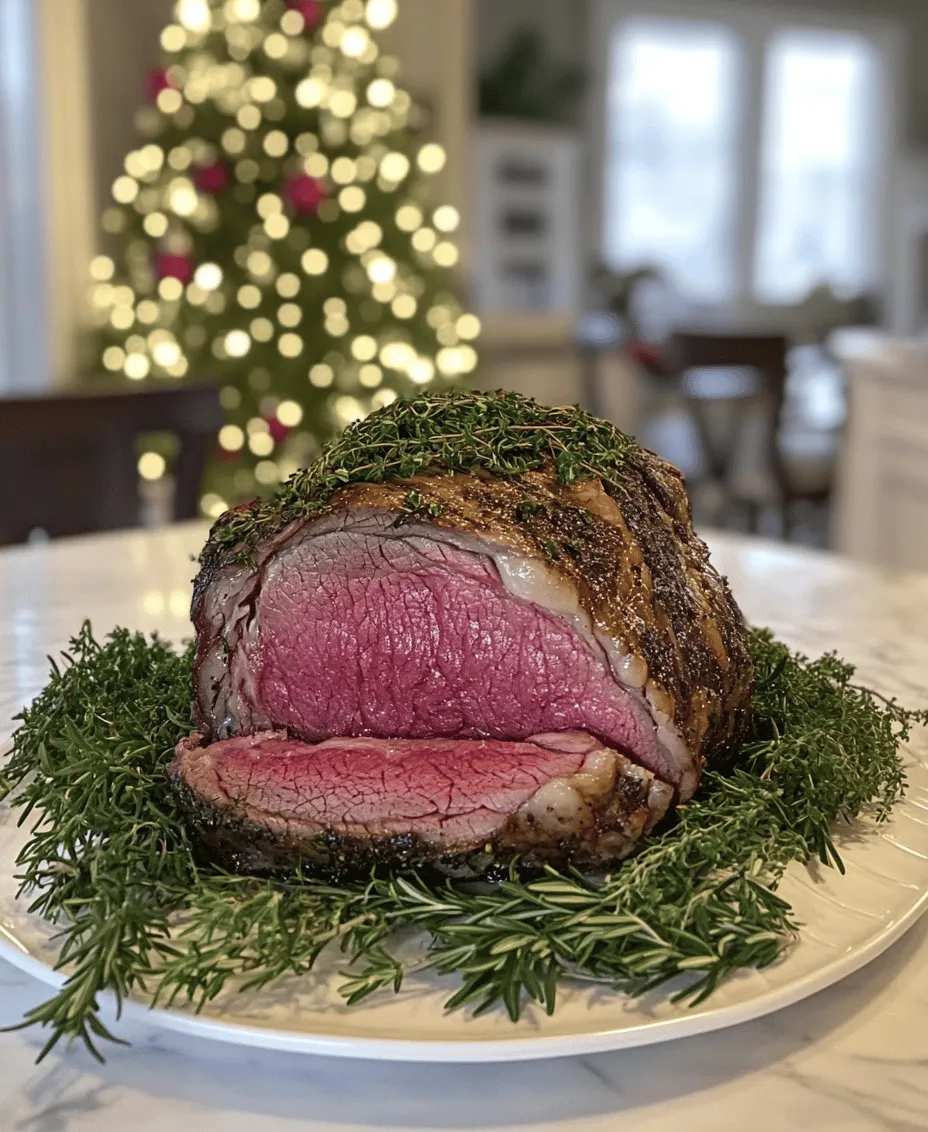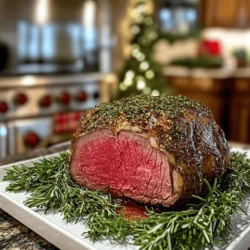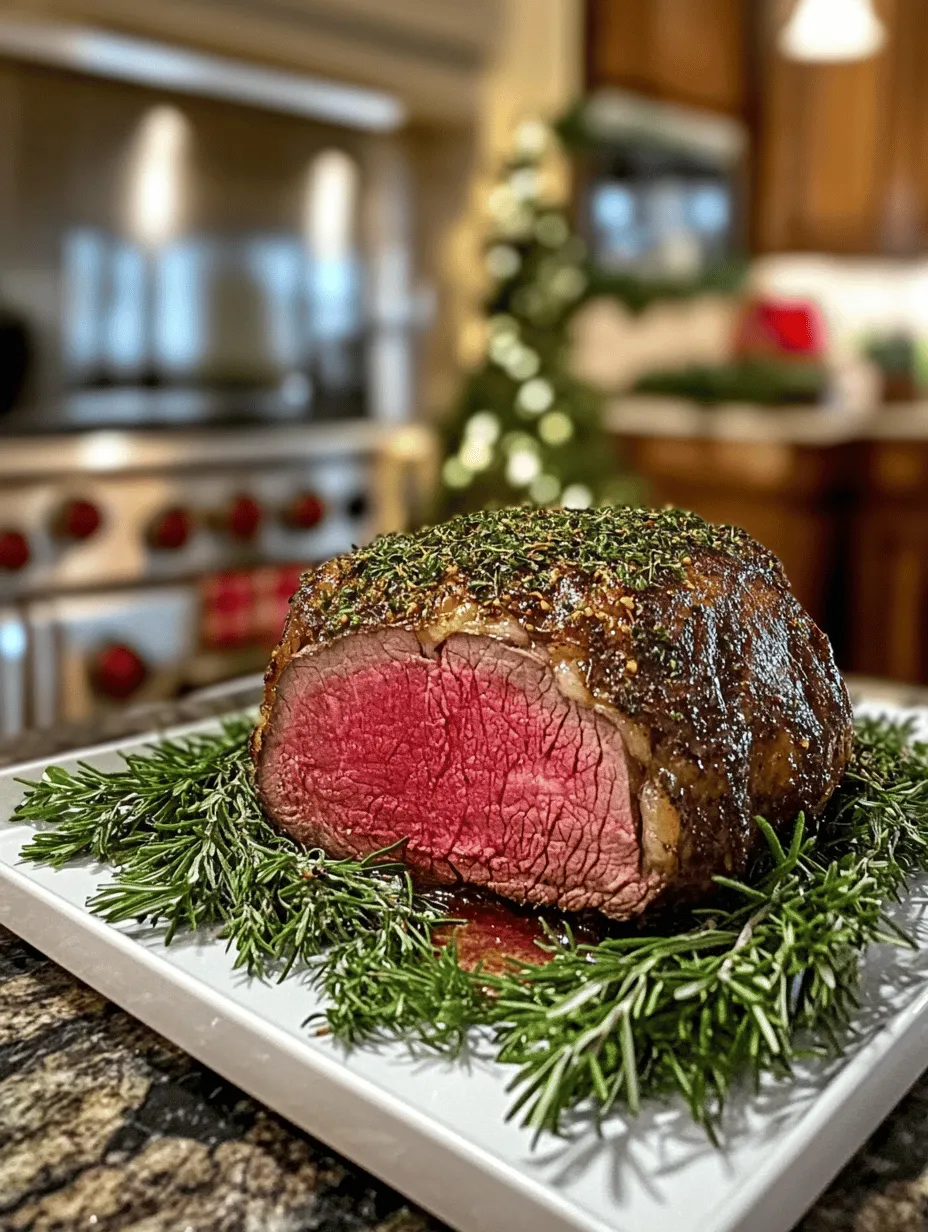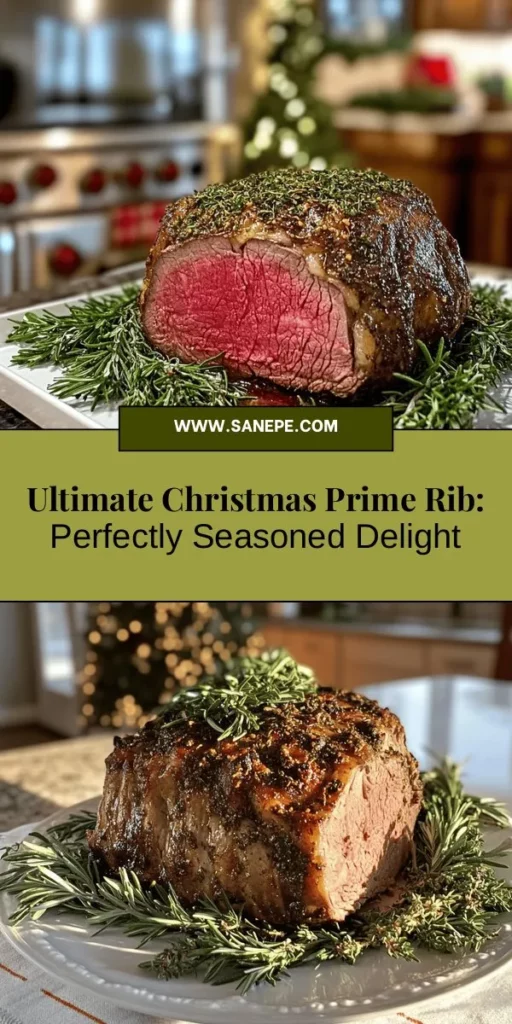Introduction
For many families, the holiday season wouldn’t be complete without a magnificent prime rib served at the Christmas dinner table. This impressive cut of beef not only makes a stunning centerpiece but also delights the palate with its rich flavor and tenderness. Prime rib is synonymous with festive celebrations, evoking memories of joyful gatherings and cherished traditions. The key to making your Christmas prime rib unforgettable lies in the careful selection of ingredients, expert seasoning, and precise cooking techniques.
As you embark on the journey to create the perfect Christmas prime rib, understanding the nuances of the meat itself and the art of seasoning will set you up for success. From the initial rub to the final roast, each step is crucial in achieving that mouthwatering flavor and beautiful presentation. In this article, we’ll guide you through every detail of crafting a perfectly seasoned Christmas prime rib, ensuring that your holiday feast is a memorable one.
Understanding Prime Rib
Definition and Origin of Prime Rib
Prime rib, also known as standing rib roast, is a highly prized cut of beef that comes from the primal rib section of the cow. It is renowned for its marbling, which contributes to its tenderness and flavor. The term “prime” refers to the USDA grading system, indicating that the meat possesses superior quality and marbling compared to other cuts.
Historically, prime rib has been a staple in celebratory feasts, particularly during the holidays. Its roots can be traced back to traditional British Sunday roasts, where a joint of beef would be slow-cooked and served with rich accompaniments. Today, prime rib is a popular choice for festive occasions, especially Christmas, where it takes center stage at family gatherings and holiday parties.
Differences Between Bone-in and Boneless Prime Rib
When selecting prime rib, you’ll encounter two main types: bone-in and boneless.
– Bone-in Prime Rib: This cut retains the rib bones, which not only adds flavor but also helps keep the meat moist during cooking. The bones act as a natural roasting rack, allowing for even heat distribution. Additionally, many chefs believe that cooking with the bone enhances the overall taste of the meat.
– Boneless Prime Rib: As the name suggests, this cut has had the bones removed, making it easier to carve and serve. While boneless prime rib can be just as flavorful, some argue that it lacks the depth of flavor that the bone provides. This option is often preferred for those looking for convenience and ease of slicing.
Regardless of your choice, it’s essential to select high-quality meat. Look for prime cuts with ample marbling, as this fat will render during cooking, ensuring a tender and juicy roast.
Importance of Selecting High-Quality Meat for Optimal Flavor and Tenderness
Quality matters when it comes to prime rib. Opt for USDA Prime or Choice graded beef, as these cuts have the best marbling and flavor profile. Local butcher shops or specialty meat markets often provide the freshest options and may even offer custom cuts. When shopping for your prime rib, consider the following tips:
1. Look for Marbling: The small flecks of fat throughout the meat are crucial for flavor and tenderness. A well-marbled roast will be juicier and more flavorful.
2. Check the Color: High-quality beef should have a bright red color, indicating freshness. Avoid cuts that appear dull or brown.
3. Inquire About Dry Aging: Some butchers offer dry-aged prime rib, which can enhance the flavor and tenderness through the aging process. This can be a worthwhile investment for a special holiday meal.
By prioritizing quality in your meat selection, you set the foundation for an exceptional Christmas prime rib that will impress your family and friends.
Essential Ingredients for a Perfectly Seasoned Christmas Prime Rib
Creating a perfectly seasoned Christmas prime rib involves more than just the meat itself; the ingredients you choose for the seasoning rub play a pivotal role in elevating the dish’s flavor profile. Below, we’ll explore the essential ingredients that will transform your prime rib into a holiday masterpiece.
Overview of Ingredients
1. Kosher Salt: A key ingredient in any seasoning rub, kosher salt enhances the natural flavors of the meat and helps to tenderize it. It’s essential for creating a flavorful crust.
2. Fresh Herbs: Rosemary, thyme, and parsley are popular choices that add a fragrant, earthy note to the prime rib. Fresh herbs not only infuse flavor but also provide a beautiful garnish.
3. Garlic: Minced garlic adds a punch of flavor that complements the richness of the beef. Roasting garlic can also deepen its flavor, providing a sweet and savory element.
4. Black Pepper: Freshly cracked black pepper gives a subtle heat and depth to the seasoning, balancing the richness of the meat.
5. Olive Oil: This helps the rub adhere to the surface of the roast while also contributing moisture and flavor.
6. Beef Broth: Used for basting and making gravy, high-quality beef broth adds richness and moisture during the roasting process. Choosing a low-sodium option allows you to control the salt levels in your dish.
Importance of Fresh Herbs, Garlic, and Spices in Enhancing Flavor
Using fresh herbs and spices is essential for achieving robust flavor in your prime rib. Dried herbs can lose their potency over time, while fresh ingredients bring vibrant flavors that can elevate the overall taste. The combination of garlic and herbs creates a savory rub that penetrates the meat, imparting flavor from the outside in.
Additionally, spices like paprika or cayenne pepper can be added for those who enjoy a touch of heat. Experimenting with different flavor profiles allows you to customize your prime rib to suit your palate, making it a unique centerpiece for your holiday meal.
Preparing the Perfect Rub
Now that you understand the essential ingredients, it’s time to prepare the seasoning rub that will transform your prime rib into a flavor-packed dish.
Step-by-Step Instructions for Creating the Seasoning Paste
1. Gather Your Ingredients: Start by assembling all the ingredients for the rub on a clean workspace. This includes kosher salt, freshly chopped herbs (such as rosemary and thyme), minced garlic, freshly cracked black pepper, and olive oil.
2. Mix the Dry Ingredients: In a small bowl, combine the kosher salt, black pepper, and any other dried spices you wish to include. This mixture forms the base of your rub.
3. Incorporate Fresh Ingredients: Add the minced garlic and chopped fresh herbs to the dry mixture. Stir until well combined, ensuring that the herbs are evenly distributed throughout the mixture.
4. Add Olive Oil: Drizzle in the olive oil, mixing until you achieve a paste-like consistency. The oil will help the rub adhere to the roast while also adding moisture during cooking.
5. Apply the Rub: Generously apply the seasoning paste all over the surface of the prime rib, making sure to coat all sides. For best results, use your hands to massage the rub into the meat, ensuring that it penetrates deeply.
Explanation of Why Allowing the Roast to Sit with the Rub Enhances Flavor
After applying the rub, it’s crucial to let the prime rib sit at room temperature for at least 30 to 60 minutes before cooking. This resting period allows the flavors of the seasoning to penetrate the meat, resulting in a more flavorful roast. Additionally, bringing the meat to room temperature promotes even cooking, preventing the outer layers from overcooking while the inside remains underdone.
Tips on Customizing the Rub for Personal Preferences
Don’t hesitate to get creative with your seasoning rub! Depending on your taste preferences, consider adding other ingredients such as:
– Mustard Powder: Adds a tangy kick and enhances the flavor of the beef.
– Brown Sugar: Introduces a hint of sweetness that caramelizes beautifully during roasting.
– Worcestershire Sauce: A splash of this savory sauce can deepen the umami flavor of your rub.
Feel free to adjust quantities and ingredients based on what you enjoy most. The goal is to create a rub that complements the natural flavors of the prime rib while making it uniquely yours.
Cooking Techniques for Prime Rib
As you prepare to roast your perfectly seasoned prime rib, understanding the cooking techniques involved is essential for achieving the best results.
Importance of Temperature Control for Roasting
Temperature control is vital when roasting prime rib. Cooking at the right temperatures ensures that the meat is evenly cooked, tender, and juicy. The general rule of thumb is to start with a high temperature and then reduce it for the remainder of the cooking process.
1. Preheat Your Oven: Begin by preheating your oven to 500°F (260°C). This high initial temperature helps to create a beautiful crust on the outside of your roast.
2. Initial High-Temperature Roasting: Place your seasoned prime rib on a roasting rack in a shallow pan, bone side down. Roast the prime rib at 500°F for about 15 to 20 minutes. This step is crucial for developing that flavorful crust.
Following this initial roasting period, you’ll reduce the oven temperature to 325°F (163°C) and continue cooking the prime rib until it reaches your desired level of doneness. Using a meat thermometer is essential for achieving precise results.
In the next section, we will outline the remaining steps required to finish cooking your Christmas prime rib, along with tips for carving and serving the roast to impress your guests. Stay tuned for more delicious insights into creating the perfect holiday centerpiece!

Explanation of the Low and Slow Cooking Method for Achieving Desired Doneness
The low and slow cooking method is a time-honored technique that allows the prime rib to cook evenly and develop rich flavors without becoming tough. This method involves cooking the meat at a lower temperature for an extended period, which ensures that the interior reaches the desired doneness while maintaining moisture and tenderness.
Monitoring Doneness: The Role of a Meat Thermometer
When it comes to preparing prime rib, a meat thermometer is an essential tool for achieving perfect doneness. Here’s a breakdown of the different levels of doneness:
– Rare: 120°F to 125°F – The center is bright red, and the meat is cool to warm.
– Medium Rare: 130°F to 135°F – The center is warm red, and the meat is juicy and tender.
– Medium: 140°F to 145°F – The center is pink and slightly firm, with a juicy flavor.
– Medium Well: 150°F to 155°F – The meat is mostly brown with a slight hint of pink.
– Well Done: 160°F and above – The meat is uniformly brown, often resulting in a drier texture.
Importance of Resting the Meat for Optimal Juiciness
Resting the prime rib after cooking is crucial for optimal juiciness. Once removed from the oven, cover the meat loosely with aluminum foil and allow it to rest for at least 20 to 30 minutes. This resting period enables the juices to redistribute throughout the meat, ensuring that each slice is succulent and flavorful. Cutting into the meat too soon can lead to a significant loss of juices, resulting in a drier final product.
Tips for Using a Meat Thermometer Effectively
– Insert Properly: Insert the meat thermometer into the thickest part of the rib, avoiding any bones or fat, which can give inaccurate readings.
– Keep it Clean: Always clean the thermometer before and after use to prevent cross-contamination.
– Check Early: Start checking the temperature about 30 minutes before the estimated cooking time is up to avoid overcooking.
– Don’t Rush: Allow the meat to rest after removing it from the oven, as the temperature will continue to rise slightly during this time.
Basting: Enhancing Flavor and Moisture
Basting is a simple yet effective technique to enhance the flavor and moisture of your prime rib while it cooks. This process involves spooning the meat’s own drippings or a flavorful liquid over the surface of the meat at intervals throughout the cooking time.
Overview of the Basting Process and Its Benefits
Basting serves multiple purposes:
– It adds moisture, helping to keep the meat juicy.
– It enhances the flavor by redistributing the seasonings and fats.
– It aids in creating a beautiful, caramelized crust on the exterior of the roast.
When and How to Baste for Best Results
To achieve the best results:
1. Start Basting: Begin basting after the first hour of cooking. This allows the seasoning and fat to start rendering.
2. Frequency: Baste every 30 to 45 minutes, ensuring that you do not open the oven door too often, which can impact the cooking temperature.
3. Technique: Use a baster or a large spoon to scoop up the drippings from the bottom of the roasting pan. Gently pour the liquid over the top and sides of the prime rib, ensuring even coverage.
Optional Techniques for Basting Beyond Drippings
For an extra layer of flavor, consider adding:
– Herb-infused butter: Melt butter and add fresh herbs like rosemary or thyme for aromatic basting.
– Wine or broth: Use a splash of red wine or beef broth in your basting liquid to enhance the savory flavors of the prime rib.
Making the Gravy: A Complement to Your Prime Rib
A well-prepared gravy can elevate your prime rib experience, providing a rich sauce that complements the meat beautifully. Follow these steps to create a flavorful gravy from the drippings.
Step-by-Step Guide to Creating a Flavorful Gravy from Drippings
1. Collect the Drippings: Once the prime rib has rested, pour the drippings from the roasting pan into a fat separator or a bowl. Let it sit for a few minutes to allow the fat to rise to the top.
2. Skim the Fat: Carefully skim off the excess fat, leaving behind the flavorful juices. You can reserve a tablespoon or two of fat for the gravy.
3. Make a Roux: In a saucepan over medium heat, add the reserved fat and whisk in an equal amount of flour. Cook for 2-3 minutes until it turns golden brown.
4. Add Liquid: Gradually whisk in the reserved drippings and additional beef broth or water, stirring constantly to prevent lumps. Bring to a simmer until the gravy thickens to your desired consistency.
Importance of Skimming Fat for a Smooth Gravy Texture
Skimming the fat is an essential step for achieving a smooth and velvety gravy. Excess fat can make the gravy greasy and overpower the flavors of the drippings. By carefully separating the fat, you can create a well-balanced sauce that enhances the richness of the prime rib without being overly heavy.
Flavor Enhancements That Can Be Added to the Gravy
To take your gravy up a notch, consider adding:
– Red wine: A splash of red wine during the simmering process adds depth of flavor.
– Herbs and spices: Fresh thyme, rosemary, or even a pinch of garlic powder can enhance the gravy’s flavor profile.
– Mushrooms: Sautéed mushrooms can be added to the gravy for an earthy richness.
Carving and Serving the Prime Rib
Proper carving and presentation are essential to ensure that your perfectly seasoned prime rib is as visually appealing as it is delicious. Here are some techniques for slicing and serving.
Techniques for Slicing the Prime Rib Correctly
1. Use a Sharp Knife: A sharp carving knife will make clean cuts and prevent tearing the meat.
2. Slice Against the Grain: Identify the direction of the muscle fibers (the grain) and slice against it. This technique results in tender, easy-to-chew pieces.
3. Thickness of Slices: Aim for slices around 1/2 inch thick to maintain a hearty portion without overwhelming your guests.
Suggestions for Serving Options and Presentation
When it comes to serving your prime rib, presentation matters. Here are some ideas:
– Platter Presentation: Arrange the sliced prime rib on a large serving platter. Consider adding fresh herbs or a few roasted vegetables for color.
– Individual Plates: Serve slices on individual plates with a ladle of gravy drizzled on top, garnished with a sprig of rosemary or thyme for a festive touch.
– Accompaniments: Pair your prime rib with classic side dishes such as garlic mashed potatoes, roasted vegetables, or Yorkshire pudding to create a memorable meal.
Importance of Garnishing with Fresh Herbs for Visual Appeal
A simple garnish of fresh herbs not only enhances the visual appeal of your dish but also adds a burst of fresh flavor that complements the rich flavors of the prime rib. Consider using parsley, rosemary, or thyme to elevate the presentation and entice your guests.
Conclusion
A well-seasoned prime rib is more than just a meal; it’s a centerpiece for festive occasions and a testament to the effort you put into creating a memorable dining experience. By employing techniques such as low and slow cooking, proper basting, and careful carving, you can ensure that your prime rib is cooked to perfection, showcasing the rich flavors and tender texture that make it a holiday favorite.
As you prepare and share this delicious dish with loved ones, savor the process and the flavors of the holiday season. The joy of gathering around the table, sharing stories, and enjoying a beautifully crafted meal is truly rewarding. So, embrace the traditions and flavors, and let your perfectly seasoned Christmas prime rib become a cherished part of your holiday celebrations. Enjoy!


